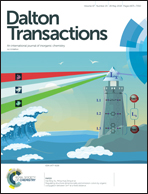Tunable dielectric transitions in layered organic–inorganic hybrid perovskite-type compounds: [NH3(CH2)2Cl]2[CdCl4−4xBr4x] (x = 0, 1/4, 1)†
Abstract
Molecular bistable dielectric switches represent a class of highly desirable intelligent materials due to their sensitive switchable responses, simple and environmentally friendly processing, light weights, and mechanical flexibility. However, most of these switches can only work at a very low temperature, extremely limiting their potential applications. Herein, three layered organic–inorganic hybrid perovskite-type compounds of the general formula A2BX4, [NH3(CH2)2Cl]2[CdCl3Br] (1), [NH3(CH2)2Cl]2[CdCl4] (2) and [NH3(CH2)2Cl]2[CdBr4] (3), which display sensitive dielectric switching reversibility and remarkable switching anti-fatigue, have been successfully designed. Differential scanning calorimetry and dielectric measurements for 1 confirm its reversible phase transition at around 166 K. Through anion modulation, the phase transition temperatures of 2 and 3 can be greatly improved up to 237 K and 254 K, respectively. Structural analysis discloses that the phase transition temperature's shifts may result from the differences among the inorganic frameworks. Moreover, due to the significant order–disorder transitions of ammonium cations, the permittivities of 1, 2 and 3 change abruptly at around the phase transition points, making them excellent stimuli-responsive electrical switches. Such an anion-modulated method will open up new possibilities of highly efficiently tuning the phase transition temperature of molecular bistable dielectric switches.
![Graphical abstract: Tunable dielectric transitions in layered organic–inorganic hybrid perovskite-type compounds: [NH3(CH2)2Cl]2[CdCl4−4xBr4x] (x = 0, 1/4, 1)](/en/Image/Get?imageInfo.ImageType=GA&imageInfo.ImageIdentifier.ManuscriptID=C8DT00353J&imageInfo.ImageIdentifier.Year=2018)


 Please wait while we load your content...
Please wait while we load your content...